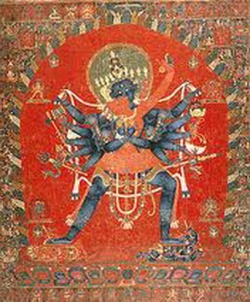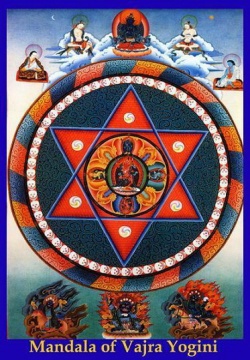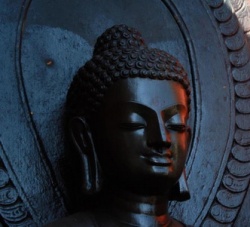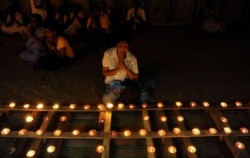Anuyoga
Anuyoga (Skt.; Tib. རྗེས་སུ་རྣལ་འབྱོར་གྱི་ཐེག་པ་, Wyl. rjes su rnal 'byor; Eng. 'subsequent yoga') — the second of the three yanas of powerful transformative methods specific to the Nyingma school. anuyoga: The unique fifth level of tantric teachings according to the Nyingma school.
Anuyoga focuses mainly on the completion stage (Tib. dzogrim), and emphasizes the inner yoga of channels, winds-energies and essences (Tib. tsa lung tiklé). Visualization of the deities is generated instantly, rather than through a gradual process as in Mahayoga.
anuyoga (S): Tibetan: je su naljor. 'further union
Anu Yoga, subsequent yoga. Syn a nu yo ga [RY]
Anu Yoga [RY]
Anuyoga [RY]
anu yoga, the subsequent yoga [IW]
anuyoga, Vehicle of the Anuyoga Tantra, Anuyoga [JV]
Anu Yoga. The second of the Three Inner Tantras, Maha, Anu and Ati. It emphasizes knowledge (prajna) rather than means (upaya) and the completion stage rather than the development stage. The view of Anu Yoga is that liberation is attained through growing accustomed to the insight into the nondual nature of space and wisdom. The Anu Yoga mandala is regarded as contained within the vajra body. Anu means 'subsequent.' [RY]
Anuyoga does have self-arising yidam practice, which is approximately that. The distinctive feature of anuyoga yidam practice is that it non-liturgical, or minimally liturgical, and non-gradual.
Rather than building up the visualization gradually according to instructions in the sadhana text, you produce the whole thing at once, based on your recollection of the felt experience of the yidam.
One advantage of this approach is that you can do it whenever you have a few spare minutes, under almost any circumstances.
As you say, the classification of Inner Tantra into three yanas is a point of pride for Nyingmas, and I think it is somewhat arbitrary.
Still, it is useful to have a word for “tantra with minimal ritual and Dzogchen view”, which is mostly what “anuyoga” means now.
(It’s meant various other things at different stages in its history, as Dalton’s PhD thesis explains.)
Second of the Nyingma three inner tantras and eighth of the Nine Yanas (vehicles).
Emphasis is placed on the Perfection Phase, especially practice on the channels and winds.
Based in tantras associated with Vajrasattva, Vimalakirti and King Dza.
These teachings also involve visualizations wherein the deity is generated instantly (as compared to gradually as is done in the lower tantras).
==Overview Given by Alak Zenkar Rinpoche[1]
The vehicle of Anuyoga , or ‘following yoga’, is so-called because it mainly teaches the path of passionately pursuing (or ‘following’) wisdom, in the realization that all phenomena are the creative expression of the indivisible unity of absolute space and primordial wisdom.
Entry Point
One’s mind is matured through the thirty-six empowerments in which the four rivers—outer, inner, accomplishing and secret—are complete, and one keeps the samayas as described in the texts.
View
Through logical reasoning one determines that which is to be known, the fact that all phenomena are characterized as being the three mandalas in their fundamental nature, and realizes that this is so.
Meditation
Meditation practice here consists of two paths. On the path of liberation one practises the non-conceptual samadhi of simply resting in a state that accords with the essence of reality itself, and the conceptual samadhi of deity practice, in which one visualizes the mandala of supporting palace and supported deities simply by reciting the mantra of generation. On the path of skilful means one generates the wisdom of bliss and emptiness through the practices of the upper and lower gateways.
Conduct
One practises the conduct that is beyond adopting or abandoning in the recognition that all perceptions are but the display of the wisdom of great bliss.
Results
At the culmination of Anuyoga’s own uncommon five yogas, which are essentially its five paths, and the ten stages that are included within these five, one attains the level of Samantabhadra.
Subdivisions
There are two sections of Anuyoga:
Tantras of Anuyoga
The Anuyoga tantras are classified as:
Four root tantras:
- The Sutra which Gathers All Knowledge: kun 'dus rig pa'i mdo (spyi mdo)
- The Sutra which Gathers All Intentions: sangs rgyas thams chad dgongs pa 'dus pa (Tib. Do Gongpa Düpa or Düpa Do)[3]
- ye shes rngam glog
- gsang ba dur khrod khu byug rol ba
Six branch tantras:
- kun tu bzang po ch'e ba rang la gnas pa'i rgyud
- dbang bskur rgyal po
- ting 'dzin mch'og
- skabs sbyor bdun pa
- srtson pa don ldan
- dam thsig bkod pa
Twelve rare tantras
The Lineage of Anuyoga
[[Image:Sangye Yeshe.jpg|thumb|250px|Nupchen Sangyé Yeshé)] King Dza, who also received the Mahayoga tantras, received the Anuyoga tantras from Vajrapani and Licchavi Vimalakirti—one of the Five Excellent Ones of Sublime Nobility who received the Anuyoga tantras from Vajrapani at the summit of Mount Malaya.
They were in turn transmitted to the siddha Kukkuraja, and then passed to Nupchen Sangyé Yeshé who taught them in Tibet.[4]
An extensive chronological list of lineage holders of the Mahayoga, from Buddha Samantabhadra to the present day, can be found in Tulku Thondup's works. (see reference below)
Source
Anuyoga (Skt. अनुयोग 'further yoga') is the designation of the second of the three Inner Tantras according to the ninefold division of practice used by the Nyingma school of Tibetan Buddhism.
As with the other yanas, Anuyoga represents both a scriptural division as well as a specific emphasis of both view and practice.
Anuyoga emphasizes the practice of the completion stage and the understanding of the mandala as being contained within our own vajra-body.
Having realized the non-duality of the expanse of emptiness and pristine wisdom, the practitioner attains accomplishment through “union” and “liberation.”
Anuyoga is called the “ensuing yoga” because it focuses on the path of the transmutation of desire into wisdom that follows the experience of bliss. Its gateway, the empowerment, is comprised of thirty-six sections.
View: All phenomena are understood as the play of our own mind.
The uncreated aspect of mind, transcending all conditions, is called the “immaculate expanse of the mother Samantabhadri,” the mandala of primordial nature.
Its all-pervading and unobstructed manifestation, which is mind's self-display, is the “wisdom father Samantabhadra,” the naturally present mandala.
These two aspects have the same nature.
They are referred to as the “child of great bliss,” in which the absolute expanse and pristine wisdom are united, representing the indivisible nature of all mandalas.
Meditation: The practitioner uses the path of skillful means that focuses on the channels, energies, and vital essences of the vajra-body. Practicing the yogas of the “upper door” and the “lower door,” leads to swift realization of inherent wisdom.
The practitioner also practices the Path of Liberation without elaboration. Having merged with the depth of non-conceptual simplicity, without intentional meditatione lets everything remain in the absolute nature, just as it is.
In formal, elaborate practice, through uttering a mantra once, the mandala with its deities arises instantly with perfect clarity, like a fish leaping out of water.
Action: The action here primarily involves resting in evenness.
There are also three actions spoken of: the “sky-like action” that comes through realizing the non-duality of the absolute expanse of emptiness and pristine wisdom;
the “king-like action,” also called the “action resembling wood burning in a bonfire,” which comes through mastering the five poisons as five wisdoms; the “uninterrupted, river-like action” that comes through realizing the sameness of samsara and nirvana.
Fruit: Within one lifetime, the practitioner actualizes the Body of Great Bliss that embodies the Four Kayas.
Position in the nine-yana schema
Anuyoga is said to emphasise the completion stage of Tantra, where the preceding division, Mahayoga emphasises the generation stage.
Dalton (2003: unpaginated) in introducing the literature of the Anuyoga-yana affirms the affiliation of the Anuyoga-yana with the 'completion stage' or the 'perfection stage':
Modern-day doxographical presentations of the Nyingma school are usually based on the system of the nine vehicles (theg pa dgu). Emphasis is placed on the highest three vehicles in this scheme, namely Mahāyoga, Anuyoga, and Atiyoga.
Generally speaking, these three “inne yogas" correspond to three stages in tantric practice, namely the generation stage, during which the details of the visualizations are stabilised, the perfection stage, in which those visualizations are then employed towards familiarizing oneself with the state of enlightenment, and finally the Great Perfectione spontaneous accomplishment of buddhahood.
Being the second of the three inner yogas, Anuyoga is thus associated with the practices of the perfection stage.
Ray (2002: p. 124-125) mentions visualization, subtle body, chakra, prana, nadis, bindu and pure land:
Anuyoga-yana is associated with the feminine principle and is for those whose principal obstacle is passion. In anuyoga the emphasis shifts away from external visualization toward the completion stage, in which one meditates on the inner or subtle body with its primary energy centres (chakras), and its prana (winds or subtle energies), nadis (the inner pathways along which one's energy travels), and bindu (the consciousness). In anuyoga, all appearances are seen as the three great mandalas, and reality is understood as the deities and their pure lands.
Germano (2002: unpaginated) frames the importance of Nub Sangye Yeshe as the instigator of Anuyoga within Tibet and states that it was: "the late ninth century Nub Sangye Yeshe (gnubs sangs rgyas ye shes), who inaugurated the Anuyoga tradition in Tibet...".
Dudjom (1904-1987), et al. (1991: p. 460 History) relate an important source that impacts on the story of King Ja (particularly the narrative of the Buddhadharma relics falling from the sky upon the royal palace) a happenstance which is implied to be concurrent with the emergence of the texts of Anuyoga in Sri Lanka with the provision of a quote of what Dudjom et al. identify as a "prediction" found in the fifth chapter of the 'Tantra which Comprises the Supreme Path of the Means which Clearly Reveal All-Positive Pristine Cognition' (Wylie: kun bzang ye shes gsal bar ston pa'i thabs kyi lam mchog 'dus pa'i rgyud, Nyingma Gyubum Vol.3) which Dudjom, et al., render in English thus:
The Mahayoga tantras will fall onto the palace of King Ja. The Anuyoga tantras will emerge in the forests of Singhala [Dudjom et al. identify Singhala as located in Ceylon).
View
The particular view of Anuyoga is to realise the essence of the 'Threefold Maṇḍala of Samantabhadra' (Wylie: kun tu bzang po dkyil 'khor gsum):
"empty basic space" (Wylie: skyes med pa'i dbyings): the 'Primordial Maṇḍala of Samantabhadrī' (Wylie: ye ji bzhin pa'i dkyil 'khor)
"wisdom" (Wylie: Ye shes): the 'Natural Maṇḍala of Spontaneous Presence'(Wylie: rang bzhin lhun grub kyi dkyil 'khor)
"union of emptiness and wisdom" (Wylie: chos kyi dbyings kyi ye shes): the 'fundamental Maṇḍala of Enlightenment' (Wylie: byang chub sems kyi dkyil 'khor)
Stated differently:
The three mandalas of: Kuntuzangmo, the unborn dharmadhatu (dByings skye med kun tu bzang mo’i dkyil ’khor); whose unobstructed skillful means of luminosity is the mandala of Kuntuzangpo, the yeshe wisdom (Ye.shes kun tu.bzang po’i dkyil ’khor); and their inseparable union is the mandala of Great Bliss their son (Sras bde ba chen po’i dkyil ‘khor).
Texts
Anuyoga is the middle category of the inner Tantras for the Nyingma school. This doxographical category, often called 'mdo' (Wylie; Sanskrit: sūtra; English: 'thread', 'continuity'), is not to be confused with the non-Tantric category by the same name. It contains several works that designate themselves as sūtras, as well as the important text "Compendium of the Buddhas' Intentionality" (Sanskrit: Sarvatathagata svabhabhi sasa tantra, Wylie: sangs rgyas dgongs 'dus) or Compendium of the Intentions (Wylie: dgongs pa ’dus pa’i mdo). This text which may or may not have ever existed in India; according to the colpohon it was translated from the language of Gilgit (bru sha), from whence all of the Anuyoga texts are said to have been brought to Tibet.
Altogether, there are three volumes of Anuyoga tantras amounting to nearly three thousand pages of Tibetan text. Although the mTshams brag edition of The Collected Tantras does not rigorously organise its texts according to sub-categories, the Anuyoga category may be further subdivided according to the following scheme from Dudjom Rinpoche (Dudjom, et al. 1991: p. 289) which varies from the earlier catalogues canonised by Jigme Lingpa and that of Dampa Deshek:
The four root sutras (Wylie: rtsa ba'i rgyud bzhi)
The six tantras clarifying the six limits (Wylie: mtha’ drug gsal bar byed pa’i rgyud drug)
The twelve rare tantras (Wylie: dkon rgyud bcu gnyis)
The Seventy Literary Scriptures (Wylie: lung gi yi ge bdun cu)
The four root sutras (Wylie: rtsa ba’i mdo bzhi)
Compendium of the Buddhas' Intentionality (Sanskrit: Sarvatatathagata svabhabhi sasa tantra, Wylie: sangs rgyas dgongs 'dus) or Compendium of the Intentions (Wylie: dgongs pa ’dus pa’i mdo)
Knowing of All the Gathered (Wylie: kun ’dus rig pa’i mdo)
Play of the Charnel Ground Cuckoo (Wylie: dur khrod khu byug rol ba)
Lightning (Wylie: ye shes rngam pa klog gi ‘khor lo)
The six tantras clarifying the six limits (Wylie: mtha’ drug gsal bar byed pa’i rgyud drug)
kun tu bzang po che ba rang la gnas pa’i rgyud
dbang bskur rgyal po
ting ’dzin mchog
skabs sbyor bdun pa
brtson pa don bden
dam tshig bkod pa
The twelve rare tantras (Wylie: dkon rgyud bcu gnyis)
zhi ba lha rgyud
chos nyid zhi ba’i lha rgyud
khro bo’i lha rgyud chen mo
[[khro bo’i lha rgyud rtogs pa chen po
thugs rje chen po’i gtor rgyud]] (terminating colophon of the Catalogue of the Rig 'dzin Tshe dbang nor bu rNying ma'i rgyud 'bum
rnal ’byor gsang ba’i tshogs rgyud chen po
dpal ’bar khro mo
rak ta dmar gyi rgyud
me lha zhi bar gyur ba ’bar ba’i rgyud]]
khro bo’i sbyin bsregs rdo rje’i dur mo
hum mdzad chen mo]]
zla gsang chen mo
The Seventy Literary Scriptures (Wylie: lung gi yi ge bdun cu)
This list remains to be enumerated.
Mindstream
The 'mind-stream doctrine' (Sanskrit: citta santana; Wylie: thugs rgyud; sems rgyud) is a union of the 'Mind Cycle' (Wylie: sems sde) of Atiyoga and Anuyoga proper and is reinforced by the Guhyagarbha Tantra literature and the Kulayarāja Tantra which comprised a major part of the transmitted precepts of the 'Zur Lineage' (Wylie: zur lugs):
This family was responsible for first formulating the transmitted precepts as such. In doing so, they made the Compendium Sūtra a major part of their system, placing it alongside the Guhyagarbha Tantra and the kun byed rgyal po to make their famous “sūtra-tantra-mind triad” (mdo rgyud sems gsum). These three works became the chief canonical texts of the Zur’s transmitted preceptsg to the respective doxographical classes of Anuyoga, Mahāyoga, and the Mind Class of Atiyoga (sems sde).
Footnotes
- ↑ A Brief Presentation of the Nine Yanas by Alak Zenkar Rinpoche
- ↑ The sutras of Anuyoga are different from the shravaka, pratyekabuddha and bodhisattva sutras.
- ↑ P. Cornu says that this tantra is an explanation of the first one. Somehow it seems that these first two root tantras are sometimes amalgamated or confused together in modern sources.
- ↑ This needs to be checked and developed.



